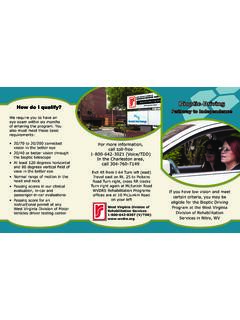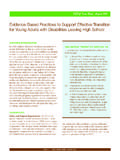Transcription of WIOA STATE PLAN FOR THE STATE OF WEST VIRGINIA
1 WIOA STATE plan FOR THE STATE OF west VIRGINIA CONTENTS WIOA STATE plan for the STATE of west VIRGINIA .. 1 Overview .. 4 Options for Submitting a STATE plan .. 5 How STATE plan Requirements Are Organized .. 7 I. WIOA STATE plan Type .. 9 Combined plan partner program(s) .. 10 II. Strategic Elements .. 11 a. Economic, Workforce, and Workforce Development Activities Analysis .. 12 b. STATE Strategic Vision and Goals .. 41 c. STATE Strategy .. 54 III. Operational Planning 59 A. STATE Strategy Implementation .. 60 b. STATE Operating Systems and Policies .. 87 IV. Coordination with STATE plan programs .. 124 V. Common Assurances (for all core programs ) .. 125 VI. Program-Specific Requirements for Core programs .. 127 Program-Specific Requirements for Adult, Dislocated Worker, and Youth Activities under Title I-B .. 128 Program-Specific Requirements for Wagner-Peyser Program (Employment Services) .. 168 Program-Specific Requirements for Adult education and Family Literacy Act programs .
2 184 Program-Specific Requirements for vocational Rehabilitation .. 217 VII. Program-Specific Requirements For Combined STATE plan Partner programs .. 364 Appendix 1. Performance Goals for the Core programs .. 365 Table 1. Employment (Second Quarter after Exit) .. 366 Table 2. Employment (Fourth Quarter after Exit) .. 367 Table 3. Median Earnings (Second Quarter after Exit) .. 368 Table 4. Credential Attainment Rate .. 369 Table 5. Measureable Skill Gains .. 370 Table 6. Effectiveness in Serving Employers .. 371 Table 7. Combined Federal Partner Measures .. 372 Appendix 2. Other STATE Attachments (Optional) .. 373 OVERVIEW Under the Workforce Innovation and Opportunity Act (WIOA), the Governor of each STATE must submit a Unified or Combined STATE plan to the Secretary of Labor that outlines a four-year workforce development strategy for the STATE s workforce development system. The publicly-funded workforce system is a national network of Federal, STATE , regional, and local agencies and organizations that provide a range of employment, education , training, and related services and supports to help all jobseekers secure good jobs while providing businesses with the skilled workers they need to compete in the global economy.
3 states must have approved Unified or Combined STATE Plans in place to receive funding for core programs . WIOA reforms planning requirements, previously governed by the Workforce Investment Act of 1998 (WIA), to foster better alignment of Federal investments in job training, to integrate service delivery across programs and improve efficiency in service delivery, and to ensure that the workforce system is job-driven and matches employers with skilled individuals. One of WIOA s principal areas of reform is to require states to plan across core programs and include this planning process in the Unified or Combined STATE Plans. This reform promotes a shared understanding of the workforce needs within each STATE and fosters development of more comprehensive and integrated approaches, such as career pathways and sector strategies, for addressing the needs of businesses and workers. Successful implementation of many of these approaches called for within WIOA requires robust relationships across programs .
4 WIOA requires states and local areas to enhance coordination and partnerships with local entities and supportive service agencies for strengthened service delivery, including through Unified or Combined STATE Plans. OPTIONS FOR SUBMITTING A STATE plan A STATE has two options for submitting a STATE plan a Unified STATE plan or a Combined STATE plan . At a minimum, a STATE must submit a Unified STATE plan that meets the requirements described in this document and outlines a four-year strategy for the core programs . The six core programs are the Adult Program (Title I of WIOA), the Dislocated Worker Program (Title I), the Youth Program (Title I), the Adult education and Literacy Program (Title II), the Wagner-Peyser Act Program (Wagner-Peyser Act, as amended by title III), and the vocational Rehabilitation Program (Title I of the Rehabilitation Act of 1973, as amended by Title IV). Alternatively, a STATE may submit a Combined STATE plan that meets the requirements described in this document and outlines a four-year strategy for WIOA s core programs plus one or more of the Combined plan partner programs .
5 When a STATE includes a Combined STATE plan partner program in its Combined STATE plan , it need not submit a separate plan or application for that particular program. If included, Combined STATE plan partner programs are subject to the common planning elements (Sections II and III of this document) where specified, as well as the program-specific requirements for that program. The Combined STATE plan partner programs are Career and technical education programs authorized under the Carl D. Perkins Career and Technical education Act of 2006 (20 2301 et seq.) Temporary Assistance for Needy Families Program (42 601 et seq.) Employment and Training programs under the Supplemental Nutrition Assistance Program ( programs authorized under section 6(d)(4) of the Food and Nutrition Act of 2008 (7 2015(d)(4))) Work programs authorized under section 6(o) of the Food and Nutrition Act of 2008 (7 2015(o)) Trade Adjustment Assistance for Workers programs (Activities authorized under chapter 2 of Title II of the Trade Act of 1974 (19 2271 et seq.))
6 Jobs for Veterans STATE Grants Program ( programs authorized under 38, 4100 et. seq.) Unemployment Insurance programs ( programs authorized under STATE unemployment compensation laws in accordance with applicable Federal law) Senior Community Service Employment Program ( programs authorized under Title V of the Older Americans Act of 1965 (42 3056 et seq.)) Employment and training activities carried out by the Department of Housing and Urban Development Community Services Block Grant Program (Employment and training activities carried out under the Community Services Block Grant Act (42 9901 et seq.))* Reintegration of Ex-Offenders Program ( programs authorized under section 212 of the Second Chance Act of 2007 (42 17532)) _____ * states that elect to include employment and training activities carried out under the Community Services Block Grant (CSBG) Act (42 9901 et seq.) under a Combined STATE plan would submit all other required elements of a complete CSBG STATE plan directly to the Federal agency that administers the program.
7 Similarly, states that elect to include employment and training activities carried by the Department of Housing and Urban Development and programs authorized under section 6(d)(4) and 6(o) of the Food and Nutrition Act of 2008 that are included would submit all other required elements of a complete STATE plan for those programs directly to the Federal agency that administers the program. HOW STATE plan REQUIREMENTS ARE ORGANIZED The major content areas of the Unified or Combined STATE plan include strategic and operational planning elements. WIOA separates the strategic and operational elements to facilitate cross-program strategic planning. The Strategic Planning Elements section includes analyses of the STATE s economic conditions, workforce characteristics, and workforce development activities. These analyses drive the required vision and goals for the STATE s workforce development system and alignment strategies for workforce development programs to support economic growth.
8 The Operational Planning Elements section identifies the STATE s efforts to support the STATE s strategic vision and goals as identified in the Strategic Planning Elements section. This section ensures that the STATE has the necessary infrastructure, policies, and activities to meet its strategic goals, implement its alignment strategy, and support ongoing program development and coordination. Operational planning elements include: o STATE Strategy Implementation, o STATE Operating Systems and Policies, o Assurances, and o Program-Specific Requirements for the Core programs , and o Program-Specific Requirements for the Combined STATE plan partner programs . When responding to Unified or Combined STATE plan requirements, states must identify specific strategies for coordinating programs and services for target populations.* While discussion of and strategies for every target population is not expected, states must address as many as are applicable to their STATE s population and look beyond strategies for the general population.
9 _____ * Target populations include individuals with barriers to employment, as defined in WIOA Sec. 3, as well as veterans, unemployed workers, and youth. The major content areas of the Unified or Combined STATE plan include strategic and operational planning elements. WIOA separates the strategic and operational elements to facilitate cross program strategic planning. The Strategic Planning Elements section includes analyses of the STATE s economic conditions, workforce characteristics, and workforce development activities. These analyses drive the required vision and goals for the STATE s workforce development system and alignment strategies for workforce development programs to support economic growth. The Operational Planning Elements section identifies the STATE s efforts to support the STATE s strategic vision and goals as identified in the Strategic Planning Elements section. This section ensures that the STATE has the necessary infrastructure, policies, and activities to meet its strategic goals, implement its alignment strategy, and support ongoing program development and coordination.
10 Operational planning elements include: STATE Strategy Implementation, STATE Operating Systems and Policies, Assurances, Program Specific Requirements for the Core programs , and Program Specific Requirements for the Combined STATE plan partner programs . (These requirements are available in a separate supplemental document, Supplement to the Workforce and Innovation Act (WIOA) Unified and Combined STATE plan Departments are not seeking comments on these particular requirements). When responding to Unified or Combined STATE plan requirements, states must identify specific strategies for coordinating programs and services for target populations. While discussion of and strategies for every target population are not expected, states must address as many as are applicable to their STATE s population and look beyond strategies for the general population. Paperwork Reduction Act: The Paperwork Reduction Act of 1995 (PRA) provides that an agency may not conduct, and no person is required to respond to, a collection of information unless it displays a valid OMB control number.



